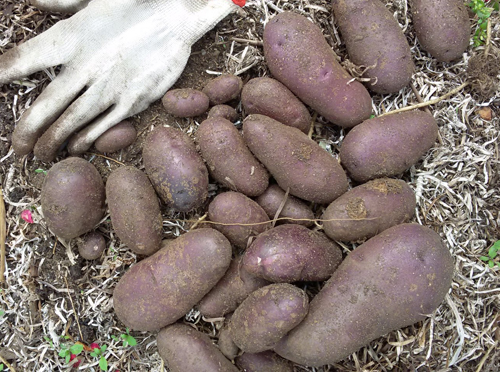Potato variety Cornflower
Cornflower is a medium-early variety of potatoes (Solanum tuberosum) for table use. Suitable for diet food. Bred in the Moscow region by specialists of the V.I. A.G. Lorkha ". It was obtained by crossing the Chugunka variety and the numbered hybrid D-31-88. In 2014, 7 years after filing an application for admission, he was included in the state register of breeding achievements of the Russian Federation. Zoned in the Central region (Bryansk, Vladimir, Ivanovsk, Kaluga, Moscow, Ryazan, Smolensk, Tula regions). Differs in blue-violet color of the peel.

The period from full germination to harvest is 80-100 days, in some regions it is slightly longer.
Plant of medium height, intermediate type. Cornflower's stems are strong, semi-erect. Leaves of medium size, open type, dark green in color. Corolla is small, pinkish-purple in color. The intensity of the anthocyanin coloration of its inner side is weak or medium.
The root system of potatoes is quite powerful, about 15 medium-sized tubers, weighing 77-112 grams each, can form on one plant, the amount of non-commodity fines is minimal. The tubers are aligned, have an elongated oval shape, often regular. The rind is thin, smooth, blue-violet; during cooking, the intensity of the blue tint is lost. The flesh on the cut has a white or light cream color; small areas with a pink-violet pigment may be observed. The eyes are small, superficial, almost invisible.
The variety showed itself well during state tests. Marketable yield was 93−256 c / ha, at the level and 67 c / ha below the standards Nevsky... The maximum amount was obtained in the Moscow region - 482 c / ha, which is comparable to the standard Bryansk delicacy. The marketability of tubers is 71-94%, keeping quality is 96%.
Vasilka has very good taste. The tubers are medium-sized, suitable for cooking any dishes, but they are especially well suited for mashed potatoes, cooking in "uniform" and peeled, baking, stuffing. When cooked, they crack, but at the same time they do not lose their shape. The pulp is weakly mealy, not watery, the starch content in it is 10-12%. This potato has high antioxidant activity, making it ideal for diet nutrition.
The variety is moderately demanding on soils and climatic conditions. Shows the best yield on light fertile soils in regions with a mild climate, especially in the Central. From an agrotechnical point of view, the variety is absolutely simple and does not require increased attention to itself, however, it will definitely respond to good care by increasing the yield and the number of commercial potatoes. Here are some tips to help you get the best results.

- Selection and calibration of tubers should be carried out before planting. For further cultivation, specimens of medium size are better suited, without mechanical damage and signs of disease. It is highly desirable to treat the seed material with disinfectants against diseases and insects, as well as, if desired, with growth stimulants.
- The site for planting a cornflower should be well prepared in advance - fertilized, plowed, plowed. It is important to choose the soil on which crops such as legumes, green manures, cabbage, onions, beets, cucumbers, garlic, and zucchini were previously grown. Do not plant tubers in the soil after other nightshades! This can lead to infection of potatoes with diseases characteristic of this crop, in particular late blight.
- During the growing season of plants, do not forget about standard agrotechnical measures. Hilling, loosening the soil, timely preventive treatments for diseases and pests, regular watering and feeding - all this will have a very positive effect on yield. By the way, the introduction of higher doses of fertilizers will help reduce the number of small tubers. But do not get carried away with nitrogen-containing complexes - their excessive amount in the soil can lead to an increase in the growth rate of tops to the detriment of tuberization.
- Do not forget to replace the seed material in a timely manner. Our hero not so long ago appeared on the wide potato market, so there is no information about his tendency to degeneration. At this point, one more thing should be mentioned. In Russia, there is a "varietal confusion" - varieties with blue-violet peel and white pulp are often very similar in appearance to tubers, which is why they are very often confused. Thus, for example, the Blue Danube or the Gypsy Woman may be mistaken for the Cornflower, while someone says that the Cornflower does not exist at all. It is very difficult to understand this kaleidoscope of opinions, so the only right decision would be to buy seed from the originator, or from a trusted bona fide seller.
The variety is resistant to golden cyst nematode, cancer, moderately resistant to banded and wrinkled mosaics. To late blight is relatively resistant to tops and tubers.
Gardeners appreciate this variety very much for its excellent taste, high yield, good keeping quality and excellent presentation of tubers. Despite their rather exotic appearance, these potatoes quickly gained popularity in gardening plots.
The disadvantages, first of all, include the poor resistance of tubers to mechanical damage due to their thin peel. You can also add here the relative vulnerability to late blight. Another small drawback is, as unexpected as it may sound, the blue-violet color of the peel. From our own experience, we can say that when harvesting, cornflower tubers are much more difficult to find in the ground than tubers of ordinary red or yellow-peeled varieties.
Potatoes are officially grown by: LLC "Agrocenter Korenevo" in the Moscow region, LLC "Fat-Agro" in North Ossetia-Alania, LLC "Redkinskaya agro-industrial company" in the Tver region, LLC "APK Lyubovskoye" in the city of Arkhangelsk.








